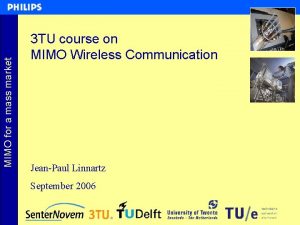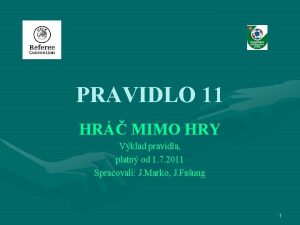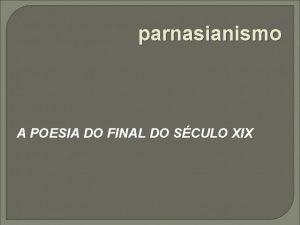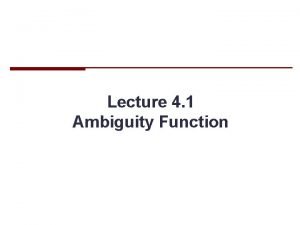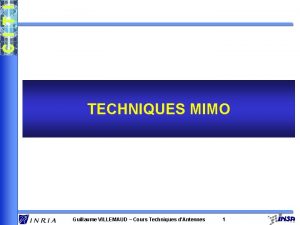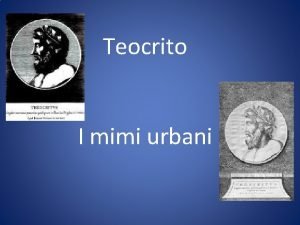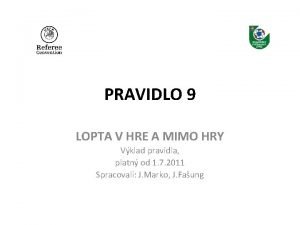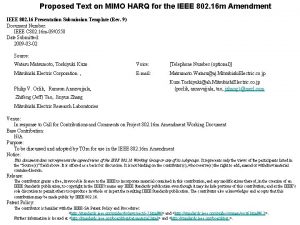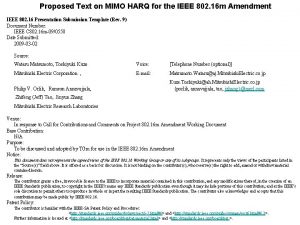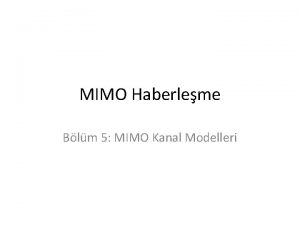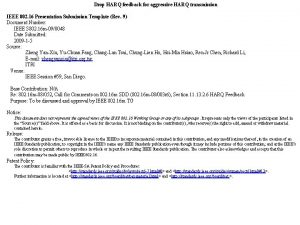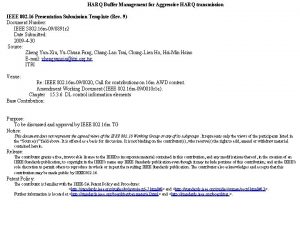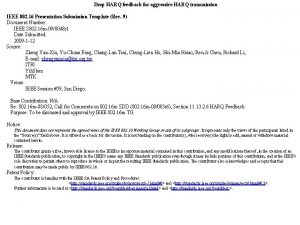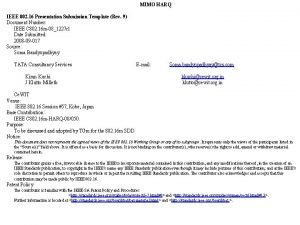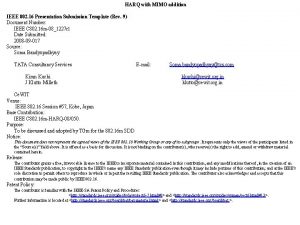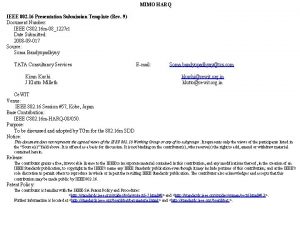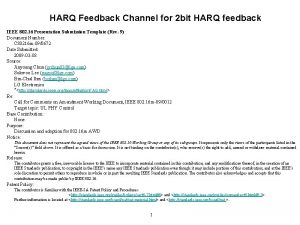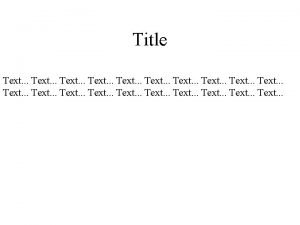Proposed Text on MIMO HARQ for the IEEE

















![Appendix B(1/2) HARQ-STC decoding method for 2 x 2 MIMO [example] Ø MMSE + linear Appendix B(1/2) HARQ-STC decoding method for 2 x 2 MIMO [example] Ø MMSE + linear](https://slidetodoc.com/presentation_image_h/2491b2c4646783f325ec9c982f37eafe/image-18.jpg)
![Appendix B(2/2) HARQ-STC decoding method for 2 x 2 MIMO [example] Ø Self-Interference Cancellation Coding Appendix B(2/2) HARQ-STC decoding method for 2 x 2 MIMO [example] Ø Self-Interference Cancellation Coding](https://slidetodoc.com/presentation_image_h/2491b2c4646783f325ec9c982f37eafe/image-19.jpg)











- Slides: 30

Proposed Text on MIMO HARQ for the IEEE 802. 16 m Amendment IEEE 802. 16 Presentation Submission Template (Rev. 9) Document Number: IEEE C 802. 16 m-09/0550 r 3 Date Submitted: 2009 -03 -09 Source: Wataru Matsumoto, Toshiyuki Kuze Voice: [Telephone Number (optional)] Mitsubishi Electric Corporation , E-mail: Matsumoto. Wataru@aj. Mitsubishi. Electric. co. jp Philip V. Orlik, Ramesh Annavajjala, Kuze. Toshiyuki@ah. Mitsubishi. Electric. co. jp {porlik, annavajjala, tao, jzhang}@merl. com Zhifeng (Jeff) Tao, Jinyun Zhang Mitsubishi Electric Research Laboratories Venue: In response to Call for Contributions and Comments on Project 802. 16 m Amendment Working Document Base Contribution: N/A Purpose: To be discussed and adopted by TGm for use in the IEEE 802. 16 m Amendment Notice: This document does not represent the agreed views of the IEEE 802. 16 Working Group or any of its subgroups. It represents only the views of the participants listed in the “Source(s)” field above. It is offered as a basis for discussion. It is not binding on the contributor(s), who reserve(s) the right to add, amend or withdraw material contained herein. Release: The contributor grants a free, irrevocable license to the IEEE to incorporate material contained in this contribution, and any modifications thereof, in the creation of an IEEE Standards publication; to copyright in the IEEE’s name any IEEE Standards publication even though it may include portions of this contribution; and at the IEEE’s sole discretion to permit others to reproduce in whole or in part the resulting IEEE Standards publication. The contributor also acknowledges and accepts that this contribution may be made public by IEEE 802. 16. Patent Policy: The contributor is familiar with the IEEE-SA Patent Policy and Procedures: <http: //standards. ieee. org/guides/bylaws/sect 6 -7. html#6> and <http: //standards. ieee. org/guides/opman/sect 6. html#6. 3>. Further information is located at <http: //standards. ieee. org/board/pat-material. html> and <http: //standards. ieee. org/board/pat >.

Background • In a spatial multiplexing MIMO system, interstream interference is a significant problem • This inter-stream interference is non-Gaussian. As a result, retransmissions and Chase combining do not improve the SIR performance. Info. bits Parity bits BS Self. Interference MS 1

Introduction Ø HARQ-CC for the MIMO stream 1 in a Mx. M SM has severe drawbacks due to self-Interference. ü STC code mapping cancel the self-interference ü With appropriate STC mapping, optimal performance can be achieved. Ø HARQ-STC for the MIMO stream 1 in a Mx. M SM requires large memory for storing channel matrices for all initial- and retransmission in the case of MRC receivers. ü MMSE+SLC* can achieve almost optimal performance despite of similar memory size as HARQ-CC case. ü (not necessary to use high complexity ML decoder) Ø HARQ-STC for the MIMO stream 1 in a 4 x 4 SM using the 16 e mapping is limited by the self-Interference. ü SICC + Alamouti mapping cancels the self-interference completely SLC : Symbol Level Combining MRC: Maximum Ratio Combining SICC: Self-Interference Cancellation Coding

An Example Table 1 illustrates the STC Code mappings per HARQ transmission for 2 transmit antennas. Initial Transmission Odd Re-transmission Even Re-transmission Space-time code incremental redundancy Table 1. STC Code mapping for 2 transmit antennas. Note : ITRI’s proposal should be investigated for 2 Tx antennas case as well

An Example (Contd. ) Table 2 illustrates the STC Code mappings per HARQ transmission for 4 transmit antennas. Initial Transmission First Re-transmission Second Re-transmission Third Re-transmission Spatial time code incremental redundancy Table 2. STC Code mapping for 4 transmit antennas. Note : Huawei and Nortel proposals should be investigated for 3 Tx antennas case.

HARQ-STC on 4 x 4 MIMO case analysis Ø Current 802. 16 e STC subpacket combining on 4 x 4 MIMO causes selfinterference self-Interference Existing 802. 16 e STC-HARQ mapping

Proposed SICC/Alamouti scheme with 4 x 4 MIMO (1) STC+SICC HARQ subpacket combining with 4 x 4 MIMO Let a channel response matrix for 4 x 4 MIMO (TX: 4, RX: 4) be H such that In the case of STC, the symbol transmissions (nth column is n-th TX symbols) are So the received signals are NO self-Interference Hadamard matrix for sub-matrices based on Alamouti code is used as SICC.

Proposed SICC/Alamouti scheme on 4 x 4 MIMO (2) (1)MRC : linear combining [after 4 th transmission] Interference-free performance Higher memory requirements to store channel matrices

Proposed SICC/Alamouti scheme on 4 x 4 MIMO (3) (2)MMSE + linear combining [after 4 th transmission] A slight sub-optimal performace. However, has smaller memory requirements Individual symbol estimates can be obtained after MMSE decoding at each reception, so the symbol level combining could be done with less memory.

Performance of MIMO HARQ (2 Tx case) 2 2 • • • Channel Coding : CTC (QPSK-1/2 -10 slots, 16 QAM-1/2 -5 slots) Codeword length : 480 bits 2 x 2 MIMO, SM (initial) + STC mapping (retransmission) : Table 1 Decoder : MMSE + soft SLC (symbol level combining) Channel Estimation : Ideal • 3. 8 d. B gain(QPSK), 5. 7 d. B gain(16 QAM) using STC mapping

Performance of MIMO HARQ (4 Tx case) • • • Channel Coding : CTC (QPSK-1/2 -10 slots, 16 QAM-1/2 -5 slots) Codeword length : 480 bits 4 x 4 MIMO. Speed=120 km/h SM (initial) + STC mapping (retransmission) : Table 2 Decoder : MMSE + soft SLC (symbol level combining) Channel Estimation : Ideal • 3~4 d. B gain(QPSK), 5~6. 2 d. B gain(16 QAM) using STC mapping

MMSE+SLC vs. MRC for MIMO HARQ • MMSE+SLC decoder has good performance with low-complexity. • • Channel Coding : CTC speed 0 km/h Codeword length : 480 bits 4 x 4 MIMO, SM (initial) + STC mapping (retransmission) : Table 2 Decoder : -MMSE + soft SLC (symbol level combining) -MRC Channel Estimation : Ideal • MMSE+SLC is better than MRC (2 nd and 3 rd Rx). • MMSE+SLC and MRC have almost the same performance(4 th Rx).

Appendix A (1/5) Performance of MIMO HARQ (4 Tx case) • • • Channel Coding : CTC Codeword length : 480 bits 4 x 4 MIMO. Speed 0 km/h SM (initial) + STC mapping (retransmission) : Table 2 Decoder : MMSE + soft SLC (symbol level combining) Channel Estimation : Ideal 6. 5 d. B~7. 8 d. B gain(16 QAM) using STC mapping

Appendix A (2/5) Performance of MIMO HARQ (4 Tx case) • • • Channel Coding : CTC , speed 30 km/h Codeword length : 480 bits 4 x 4 MIMO, SM (initial) + STC mapping (retransmission) : Table 2 Decoder : MMSE + soft SLC (symbol level combining) Channel Estimation : Ideal 2. 8~3. 8 d. B gain(QPSK), 6~7. 8 d. B gain(16 QAM) using STC mapping

Appendix A (3/5) Performance of MIMO HARQ (4 Tx case) • • • Channel Coding : CTC Codeword length : 432 bits 4 x 4 MIMO. Speed 0 km/h SM (initial) + STC mapping (retransmission) : Table 2 Decoder : MMSE + soft SLC (symbol level combining) Channel Estimation : Ideal 9 d. B~11 d. B gain(64 QAM) using STC mapping

Appendix A (4/5) Performance of MIMO HARQ (4 Tx case) • • • Channel Coding : CTC Codeword length : 432 bits 4 x 4 MIMO. Speed 30 km/h SM (initial) + STC mapping (retransmission) : Table 2 Decoder : MMSE + soft SLC (symbol level combining) Channel Estimation : Ideal 9 d. B~11 d. B gain(64 QAM) using STC mapping

Appendix A (5/5) Performance of MIMO HARQ (4 Tx case) • • • Channel Coding : CTC Codeword length : 432 bits 4 x 4 MIMO. Speed 120 km/h SM (initial) + STC mapping (retransmission) : Table 2 Decoder : MMSE + soft SLC (symbol level combining) Channel Estimation : Ideal 7. 5 d. B~8 d. B gain(64 QAM) using STC mapping
![Appendix B12 HARQSTC decoding method for 2 x 2 MIMO example Ø MMSE linear Appendix B(1/2) HARQ-STC decoding method for 2 x 2 MIMO [example] Ø MMSE + linear](https://slidetodoc.com/presentation_image_h/2491b2c4646783f325ec9c982f37eafe/image-18.jpg)
Appendix B(1/2) HARQ-STC decoding method for 2 x 2 MIMO [example] Ø MMSE + linear combining [after 2 nd transmission] For example in the case of 2 x 2 MIMO, For 1 st transmission and 2 nd transmission, we use the STBC mapping in the Table 1. Let H(1) and H(2) be channel matrices for 1 st transmission and 2 nd transmission, respectively, such that Estimated symbols by STC MMSE decoding are calculated as follows,
![Appendix B22 HARQSTC decoding method for 2 x 2 MIMO example Ø SelfInterference Cancellation Coding Appendix B(2/2) HARQ-STC decoding method for 2 x 2 MIMO [example] Ø Self-Interference Cancellation Coding](https://slidetodoc.com/presentation_image_h/2491b2c4646783f325ec9c982f37eafe/image-19.jpg)
Appendix B(2/2) HARQ-STC decoding method for 2 x 2 MIMO [example] Ø Self-Interference Cancellation Coding If H(1) and H(2) are assumed to be same as static channel, self-interference can be cancelled perfectly as follows Interference Term =0 Even if user mobility is assumed, self-interference can still be reduced as shown in our simulation results. Individual estimated symbols at each transmission can be calculated by only the channel matrix at that transmission. As a result, storing of channel matrices can be abandoned.

Appendix C(1/3) HARQ-CC, HARQ-IL, HARQ-STC decoding methods for 2 x 2 MIMO For example in the case of 2 x 2 MIMO, For 1 st transmission and 2 nd transmission, we use the STBC mapping in the table 1. Let H(1) and H(2) be channel matrices for 1 st transmission and 2 nd transmission, respectively, such that Estimated symbols by MRC and MMSE decoding are calculated as follows, Let us assume 3 type of symbols for HARQ-CC, HARQ-IL, and HARQ-STC such that, HARQ-CC Transmitted symbols HARQ-IL (symbol interleaving) HARQ-STC

Appendix C(2/3) HARQ-CC, HARQ-IL, HARQ-STC decoding methods for 2 x 2 MIMO For l=2 receptions on a time-invariant channel, Ø HARQ-CC Diversity order=2 Interference Term Same as the Interference at 1 st reception Ø HARQ-IL Diversity order=4 Ø HARQ-STC Interference Term Interference energy can be reduced as -10 log 10(l)d. B Diversity order=4 Interference Term =0

Appendix C(3/3) HARQ-CC, HARQ-IL, HARQ-STC decoding methods for 2 x 2 MIMO For l=2 receptions, If H(1) and H(2) do not change with time, self-interference can be cancelled perfectly. HARQ-CC HARQ-IL HARQ-STC (such as various Interleavers or ant. hopping) Diversity order Interference term coefficient Static channel Dynamic channel Even if dynamic channel is assumed, self-interference can be reduced more than other schemes. The performance in the worst case of HARQ-STC may be similar as the performance in the best case of HARQ-IL or HARQ-CC.

Appendix D(1/3) Performance comparison on 2 x 2 MIMO Table. D. 1 2 x 2 MIMO case (Nre=1) 10% FER rate=1/2 Gain vs. Chase Combining(d. B) STCHARQ Veh. A-30 QPSK Veh. A-120 Veh. A-30 QPSK 16 QAM Veh. A-120 Veh. A-30 16 QAM 64 QAM Veh. A-120 64 QAM 3. 1 3. 2 4. 9 4. 7 6. 0 5. 8 HARQ-IR* ? ? 1. 4 1. 55 ? ? Co. Re* - 1. 7 1. 9 3. 9 - * Reference: IEEE C 802. 16 m-09/0345, ”Mapping rule for Constellation Rearrangement”.

Appendix D(2/3) Performance comparison on 4 x 4 MIMO Table. D. 2 4 x 4 MIMO case (Nre=1) 10% FER rate=1/2 Gain vs. Chase Combining(d. B) STCHARQ Veh. A-30 QPSK Veh. A-120 Veh. A-30 QPSK 16 QAM Veh. A-120 Veh. A-30 16 QAM 64 QAM Veh. A-120 64 QAM 3. 0 2. 6 5. 5 5. 2 7. 3 6. 9 HARQ-IR ? ? ? Co. Re - - ? ?

Appendix E(1/3) ML Decoding and MMSE decoding MIMO STC can be decoded by both MMSE and MLD. Please remind that MLD needs equalizer. Equalizer and MMSE complexity are almost same as follows, and Equalizer complexity is very low in comparison with MLD one. Ø Equalizer + hard decision (most simplest receiver) ZF-Equalizer Small circuit Ø MMSE+ Symbol combining + hard decision memory MMSE Equalizer Ø ML Decoder (matrix-vector multiplication, Euclidean distance calculation, sorting ) High complexity for 64 QAM and 4 x 4 MIMO case

Appendix E(2/3) Comparison of HARQ-STC-SICC and HARQ-Co. Re HARQ Type HARQ-STC-SICC HARQ-Co. Re Metric Receiver Options With 1 reception: MMSE can be used. MMSE is inferior to ML With 2 receptions: MRC = ML MMSE is slightly inferior to MRC MLD can be formulated irrespective of the number of receptions Diversity Order =1 with MMSE and 1 reception =4 with MRC/MMSE with 2 receptions = 1 with ML and 1 reception Between 2 and 4 with ML and 2 receptions Implementation Complexity MRC and MMSE and linear receivers. Simple to implement Both full-scale MLD and reduced-complexity sphere decoders are more expensive than the MRC and MMSE receivers

Appendix E(3/3) ML Decoding with HARQ-Co. Re Decoding Complexity is of the order of M 1*M 2

Text Proposal for AWD(1/3) ---------------------- Start of the Text ------------------------ • 15. 3. xx MIMO HARQ For HARQ subpacket retransmission, the mapping of bits or modulated symbols to spatial streams may be applied to exploit spatial diversity with given mapping pattern, depending on the type of IR. In this case, the predefined set of mapping patterns should be known to both transmitter and receiver. • 15. 3. xx STC Code Mapping In the STC transmission, for both DL and UL, the STC subpacket retransmission can be generated by using the Space time code incremental redundancy version. The transmission rule for space-time coded incremental redundancy codes set is listed in Tables 1 through Table 3. The MS shall process the initial transmission, first retransmission, and second retransmission, etc. , in the form of space time decoding. ----------------------- End of the Text -------------------------

Text Proposal for AWD(2/3) ---------------------- Start of the Text ------------------------Table 1 illustrates the STC Code mappings per HARQ transmission for 2 transmit antennas. Table 1. STC Code mapping for 2 transmit antennas. Initial Transmission Odd Re-transmission Even Re-transmission Spatial time code incremental redundancy Table 2 illustrates the STC Code mappings per HARQ transmission for 3 transmit antennas. Table 2. STC Code mapping for 3 transmit antennas. Initial transmission First Re- transmission Second Re-transmission Third Re-transmission Spatial time code incremental redundancy ----------------------- End of the Text -------------------------

Text Proposal for AWD(3/3) ---------------------- Start of the Text ------------------------Table 3 illustrates the STC Code mappings per HARQ transmission for 4 transmit antennas. Table 3. STC Code mapping for 4 transmit antennas. Initial transmission First Re- transmission Second Re-transmission Third Re-transmission Spatial time code incremental redundancy ----------------------- End of the Text -------------------------
 Making connections images
Making connections images Kyssande vind
Kyssande vind Mimo for dummies
Mimo for dummies Postavenie mimo hry
Postavenie mimo hry Parnasianismo slides
Parnasianismo slides Mimo
Mimo A mami
A mami Mackenzie não caracteriza a estética parnasiana
Mackenzie não caracteriza a estética parnasiana Cours mimo
Cours mimo Amore di cinisca
Amore di cinisca Lopta mimo hry
Lopta mimo hry Mimo
Mimo Plats för toran ark
Plats för toran ark Vad är hsil
Vad är hsil Publik sektor
Publik sektor Ro i rom pax
Ro i rom pax Datorkunskap för nybörjare
Datorkunskap för nybörjare Vad är verksamhetsanalys
Vad är verksamhetsanalys Returpilarna
Returpilarna Matematisk modellering eksempel
Matematisk modellering eksempel Tack för att ni har lyssnat
Tack för att ni har lyssnat Vishnuismen
Vishnuismen Tack för att ni lyssnade bild
Tack för att ni lyssnade bild Cks
Cks Läkarutlåtande för livränta
Läkarutlåtande för livränta Nyckelkompetenser för livslångt lärande
Nyckelkompetenser för livslångt lärande Inköpsprocessen steg för steg
Inköpsprocessen steg för steg Strategi för svensk viltförvaltning
Strategi för svensk viltförvaltning Personlig tidbok fylla i
Personlig tidbok fylla i Egg för emanuel
Egg för emanuel Stickprovsvariansen
Stickprovsvariansen


